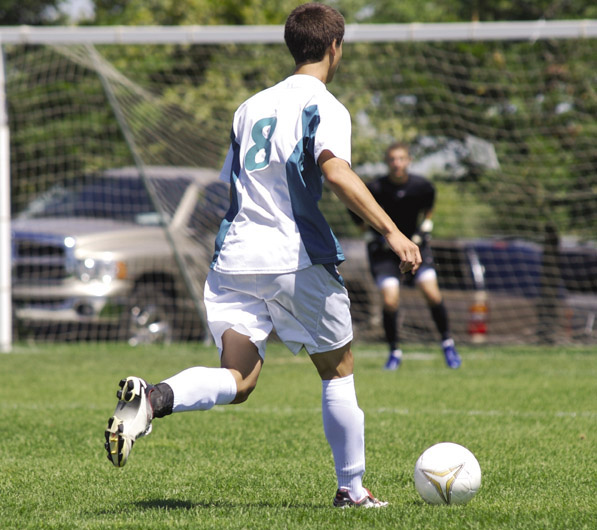
istock 3620647
by Jordana Bieze Foster
Hamstring work takes timing
Data support training during cool-down
Eccentric hamstring strengthening exercises performed during cool-down rather than warm-up may protect against the effects of fatigue and further reduce injury risk in soccer players, according to research from the University of Hull in the U.K.
The so-called Nordic hamstring lowers exercises have been enjoying a recent surge in popularity, particularly in light of a 2008 Norwegian study that found a significantly lower rate of hamstring strain in soccer teams that incorporated the exercises into their warm-up protocols. Now the findings from Hull, published in the July issue of the Journal of Strength and Conditioning Research, suggest that hamstrings training after a workout may be even more effective.
The British study involved 16 semiprofessional soccer players who participated in an eight-week intervention period involving Nordic hamstring exercises twice a week. Half of the players did hamstrings training prior to their workouts, and the other half did the same exercises as part of their cool downs. In these exercises, the athlete starts from an elevated kneeling position and then lowers (and raises) his body without flexing at the hips.
Before and after the eight-week intervention period, researchers tested the players’ hamstring strength as a function of fatigue. The athletes performed a 90-minute multidirectional exercise protocol designed to simulate a soccer match, and hamstring strength was tested prior to the protocol, at “halftime,” and immediately after completion.
In other studies utilizing a similar game-length exercise protocol, the Hull group has documented the effects of fatigue on hamstring function. In the March-April issue of the Journal of Athletic Training, they reported significant decreases in peak eccentric knee flexor torque during the second half of the protocol. And in the August issue of the International Journal of Sports Medicine, they described significant time-dependent changes in sprint kinematics (reductions in combined maximal hip flexion and knee extension angle) that are suggestive of shorter hamstring muscle length.
In the July JSCR study, eccentric hamstring peak torque and the functional eccentric hamstrings-concentric quadriceps ratio at eight weeks were significantly greater in the warm-up group than the cool-down group when measured prior to the start of the simulated game. But the same strength measures were significantly greater in the cool-down group when measured at halftime and at the end of the simulation, suggesting that hamstrings exercises performed during cool-down helped players resist the effects of fatigue.
The 2008 Norwegian intervention study, published in the Scandinavian Journal of Medicine & Science in Sports, found that the incidence of hamstring strain was decreased by more than half in teams that included Nordic hamstring lowers into their warm-up regimens. Given that a 2004 study of British professional soccer players found that 42% of hamstring strains occur during the final 15 minutes of each half, the Hull findings suggest that altering the timing of the same intervention could reduce strain rates even further.
A Brazilian study in the July issue of Manual Therapy offers a possible explanation for the positive effect of the exercises.
Researchers randomized 45 subjects with tight hamstrings to one of two intervention groups or a control group. Subjects in the intervention groups did either stretching exercises or strengthening exercises in a lengthened position, three times a week for eight weeks.
At the end of the eight weeks, subjects in both exercise groups demonstrated a significant increase in hamstring stretch tolerance. But only those who performed the strengthening exercises exhibited a significant torque-angle curve shift in the direction of knee extension, which suggests a change in muscle length.
Study links history of meniscectomy to shorter professional football career
A study of National Football League players suggests that meniscectomy takes a significantly greater toll on an athlete’s ability to perform than anterior cruciate ligament surgery.
Researchers from Washington University in St. Louis analyzed NFL combine data from 1987 to 2000 and identified 94 players who entered the league with a history of meniscectomy and/or ACL surgery. The professional careers of the 54 athletes with a history of meniscectomy were 1.5 years shorter than matched players who entered the league with no history of injury, a statistically significant difference.
However, the NFL careers of 29 athletes with a history of ACL reconstruction did not differ significantly from uninjured athletes in terms of numbers of years or games played. The 11 athletes who had undergone both ACL surgery and meniscectomy went on to careers that were two years shorter than controls, although that difference was not statistically significant because of the small sample size.
The results were presented in July at the annual meeting of the American Orthopaedic Society for Sports Medicine.
Taping for ankle instability controls plantar flexion, even after exercise
Ankle taping significantly decreases plantar flexion in patients with chronic ankle instability, even after exercise, according to research from Ireland.
Investigators from University College Dublin analyzed sagittal plane motion and rearfoot frontal plane motion in 11 subjects with unilateral chronic ankle instability as they performed single leg drop landings under three test conditions: no tape, tape, and post-exercise tape. For the third condition, the individuals completed a series of hopping, ladder and cutting drills while wearing the tape, then performed the drop landing test.
No effect of the tape on rearfoot motion was observed. At 50 msec prior to contact, the tape decreased ankle plantar flexion by 7.7º before exercise and 8.3º after exercise. At initial contact, both the tape and post-exercise tape conditions were associated with 5.3º less plantar flexion. Both tape conditions were significantly different from the no tape condition but did not differ significantly from each other.
The findings were published in the August issue of the Archives of Physical Medicine & Rehabilitation.









